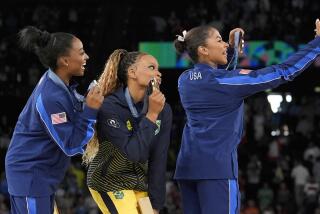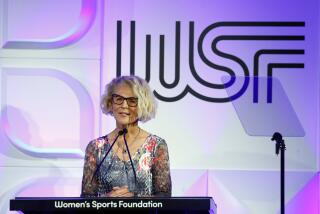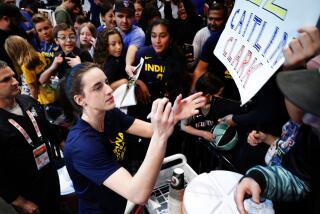Racquetball’s Queen Looks to Legitimize Sport
- Share via
NEW YORK — Lynn Adams says 90% of racquetball is played from the neck up. The national women’s champion, however, considers herself lucky to be able to play at all from the shoulders down.
At age 16, a talented athlete and distance runner, Adams was diagnosed as having rheumatoid arthritis--one of the most severe, painful and often crippling forms of the disease.
“I didn’t know anything about arthritis when I found out about it,” said the 28-year-old Californian. “When I met a person who had been crippled by it, it blew me away.”
Sometimes having to slip her racket into a hand closed and painfully locked by the disease, Adams has for the past five years blown away her competition.
Since helping form the Women’s Professional Racquetball Assn. in the summer of 1980, Adams has won 22 tournament titles, three national championships and an almost unfair 87% of all matches.
Adams also travels the country as chief advocate for the sport that in less than 10 years has grown from the parochial pastime of fitness-crazed Californians to a legitimate candidate as an Olympic event.
“The amount of people that play racquetball is huge,” Adams said, estimating that 200 people play it on the men’s and women’s professional tours and another 10 million for recreation. “It’s a great sport for the masses.”
The sport is currently a Level III Olympic event and is played at the Pan American and World Games. Adams said the sport has enjoyed remarkable success in Canada, Japan, Mexico and much of South America.
“The first time I played was on a date,” said Adams, who managed, through an early diagnosis of her arthritis and strict regimen of exercise and rest, to continue competitive athletics. “It was just a sport and any sport was OK with me. But I was immediately taken with it because it involved all the aspects of other sports--quickness, speed, agility and endurance.”
Adams ended her relationship with the unfortunate suitor on her racquetball date by soundly beating him and she has ended any number of other players’ tournament hopes during seven years on the women’s tour.
“I think my chief weapon in racquetball is that I am able to play different styles of games,” said Adams, who readily admits she is neither the hardest hitting nor fastest player on the circuit. “There are two styles. The power game and the control game and I am able to do both.”
With the physical aspects of the game mastered, Adams concentrated on the mental preparation and discipline the game demanded. She regularly plotted out possible strategy developments, sketching them on paper and rehearsing them in her imagination.
She discovered that her continuing struggle with the disease that attacked different parts of her body randomly and without warning was excellent training for top-notch racquetball.
“If I had it in my hands, perhaps I wouldn’t do a sport with my hands that day,” said Adams, who still requires regular medication to relieve the worst of the pain. “But I could go out and do a running workout or lift weights with my legs.
“It’s the same thing in racquetball. You have to find ways to get around your opponent to stay in control.”
One opponent she couldn’t get around was Heather McKay. Adams and McKay, a former Australian national squash champion, met in the finals in what Adams says was “about 97% of the tournaments.”
“We would just go out and really beat each other up,” Adams said of the 43-year-old McKay. “Over our careers, she was ahead 16-14 and I’m mad that she’s leaving before I have a chance to even the score.”
McKay recently retired to head a national squash program in Australia.
“Her leaving, however, is going to be very good for women’s racquetball in one way,” Adams said. “There’s a core group of extremely talented women that is very motivated right now because there is a slot open at the top of the game.”
The top of the game is becoming an increasingly lucrative place to reside. Adams made nearly $100,000 last year in prize money and endorsement contracts.
The nine-month tour, running from September to June, touches base in as many as 15 sites across the country and there are plans to build a portable racquetball court that can used for holding events in open-air arenas rather than in individual health clubs.
The cramped quarters of the four-walled courts and the 200-1,000 seat clubs, Adams maintained, has done a lot to enhance the sport’s popularity among spectators.
“You are right next to your opponent all the time,” she said. “You are not across the net, they are not out in some field. They are next to you and you can never get away from them.
“In addition, you are face to face with everyone in the stands. You’ll have people on the other side of the glass who are two feet away from you. It creates a lot of excitement and emotion and tension. But that’s where the mental part comes in.”
For Lynn Adams, using her head has often been the easy part.
More to Read
Go beyond the scoreboard
Get the latest on L.A.'s teams in the daily Sports Report newsletter.
You may occasionally receive promotional content from the Los Angeles Times.






